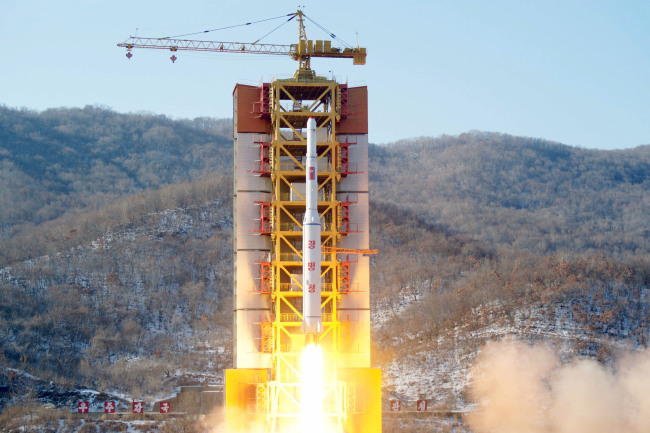[NEWSMAKER] North Korea's rocket launch reaffirms evolving missile tech
By KH디지털2Published : Feb. 10, 2016 - 15:39
North Korea’s long-range rocket launch on Sunday reaffirmed Pyongyang’s evolving missile technology, though it has yet to complete much tougher tasks such as acquiring miniaturization and atmospheric reentry technologies.
Seoul’s Defense Ministry said that the three-stage rocket that the North fired on Sunday appears to have a range of some 12,000 kilometers -- far enough to strike the U.S. mainland.
It also noted that Pyongyang had put a satellite into orbit for the second consecutive time -- an indication that the communist state’s rocket technology had “stabilized.”
The rocket, which Seoul and Washington say could be converted into a missile, is also thought to be capable of carrying a payload of up to 250 kilograms -- still shy of the capability to carry a nuclear warhead, which weighs roughly 500 kilograms, officials explained.
Observers said that the latest launch showed that Pyongyang’s missile program has made progress and is moving toward producing a genuine intercontinental ballistic missile that can threaten the U.S. and its allies in the region.
The toughest challenge for China to develop an operational ICBM is to secure reentry technology. As the intercontinental missile reenters the earth at a speed of Mach 20, it needs to be capable of withstanding temperatures of around 6,000-7,000 degrees Celsius. Observers believe that the North might have reentry technology for mid-range missiles by now.
But some analysts say that because Pyongyang has sought to develop ballistic missiles since the 1970s, it will be a matter of time for the provocative regime to perfect the reentry technology.
Seoul’s Defense Ministry said that the three-stage rocket that the North fired on Sunday appears to have a range of some 12,000 kilometers -- far enough to strike the U.S. mainland.
It also noted that Pyongyang had put a satellite into orbit for the second consecutive time -- an indication that the communist state’s rocket technology had “stabilized.”
The rocket, which Seoul and Washington say could be converted into a missile, is also thought to be capable of carrying a payload of up to 250 kilograms -- still shy of the capability to carry a nuclear warhead, which weighs roughly 500 kilograms, officials explained.
Observers said that the latest launch showed that Pyongyang’s missile program has made progress and is moving toward producing a genuine intercontinental ballistic missile that can threaten the U.S. and its allies in the region.
The toughest challenge for China to develop an operational ICBM is to secure reentry technology. As the intercontinental missile reenters the earth at a speed of Mach 20, it needs to be capable of withstanding temperatures of around 6,000-7,000 degrees Celsius. Observers believe that the North might have reentry technology for mid-range missiles by now.
But some analysts say that because Pyongyang has sought to develop ballistic missiles since the 1970s, it will be a matter of time for the provocative regime to perfect the reentry technology.

Since its 1998 test of the Taepodong-1 missile, the North has carried out a total of six long-range rocket tests including the latest one.
Experts say the latest test in 2012 showed that it can get a missile to travel some 10,000 kilometers -- far enough to reach the U.S. mainland.
Apart from the land-based launch platform, the North has been pushing to develop an underwater nuclear-capable missile system. Last May, it claimed to have carried out an ejection test for a submarine-launched ballistic missile. It is also thought to have conducted SLBM tests in November and December.
Fears about the SLBM stem from the North’s potential “second-strike capability” to launch a sudden nuclear retaliation if it suffers a “first strike” from enemy forces.
The second-strike capability forms the basis of a condition referred to as “mutual assured destruction” that maintained the “balance of terror” between the U.S. and Soviet Union during the Cold War. SLBMs are at the core of the capability as submarines can launch targeted surprise attacks on enemy forces.
Pyongyang’s pursuit of advanced missile technology has given Seoul and Washington justification to fortify missile defense on the Korean Peninsula. The allies will soon begin formal talks over the deployment of the Terminal High-Altitude Area Defense system, which Beijing and Moscow have opposed.
By Song Sang-ho (sshluck@heraldcorp.com)



![[Herald Interview] 'Amid aging population, Korea to invite more young professionals from overseas'](http://res.heraldm.com/phpwas/restmb_idxmake.php?idx=644&simg=/content/image/2024/04/24/20240424050844_0.jpg&u=20240424200058)












![[KH Explains] Korean shipbuilding stocks rally: Real growth or bubble?](http://res.heraldm.com/phpwas/restmb_idxmake.php?idx=652&simg=/content/image/2024/04/25/20240425050656_0.jpg&u=)

